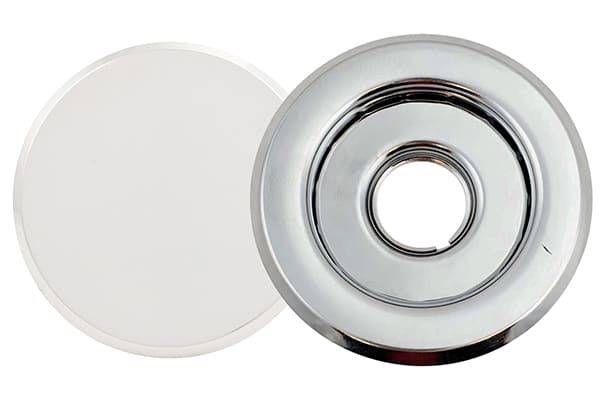Both types of fire sprinklers stress aesthetics and safety—but installation, availability, and appearance may vary greatly
Let’s get right to the answer: concealed sprinkler heads completely cover a fire sprinkler with a cover plate, while recessed sprinkler heads remain exposed and surrounded by a disc-shaped escutcheon. Each has cosmetic benefits. But neither can be bought willy-nilly: leading fire codes almost always require cover plates and escutcheons to be an exact match with the sprinklers they attach to.
This article offers a need-to-know look at recessed and concealed sprinkler heads. We explain:
- How cover plates and escutcheons work with different types of fire sprinkler heads
- How to choose between recessed and concealed types
- Why cover plates and escutcheons can’t be painted, and how a wide range of aesthetic choices (including custom paint) make aftermarket alterations unnecessary
If you’d like, you can also browse QRFS’ selection of fire safety equipment, including:
- A wide variety of commercial fire sprinklers, including concealed sprinklers and sidewall heads and pendent (ceiling-mounted) models that pair with escutcheons.
- Residential sidewall, pendent, and concealed pendent types
- Cover plates for concealed sprinklers, including some for sloped ceilings and cleanrooms
- Recessed escutcheons from Tyco, Victaulic, Senju, Viking, and Reliable, as well as retrofit-ready white and chrome types for heads with 1/2″ threads
Cover plates and escutcheons help two different types of fire sprinklers install easily, look good, and activate on time
Heat and appearance are the key factors
Most fire sprinklers fall into one of three categories:
- Pendent heads, which hang from a ceiling
- Sidewall heads that connect to pipes behind walls
- Upright heads, which face upward
Cover plates can conceal pendent or sidewall heads as part of a full concealed-sprinkler assembly. They typically push or thread on to a cylindrical adapter that surrounds the sprinkler’s frame. When covers are fully secured, they usually rest flush against the wall or ceiling, leaving the surface (relatively) smooth.
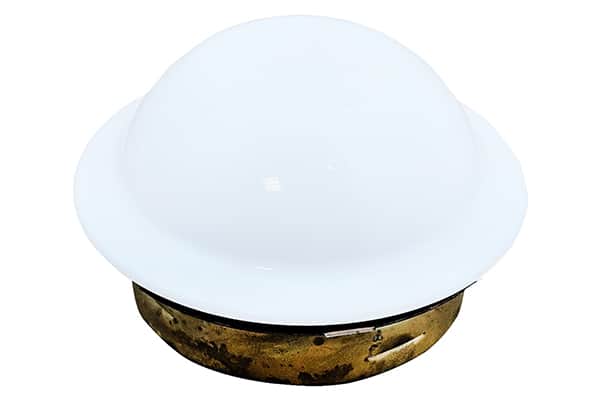
Escutcheons, however, leave the sprinkler head exposed. The most basic escutcheons are flush, which means that the base of a sprinkler’s frame will be even with the wall or ceiling. But recessed escutcheons allow the base of the sprinkler to sit slightly above the ceiling (or inside a wall). The escutcheon’s outer ring will remain flat against the surface, even as the inner ring recesses with the head.
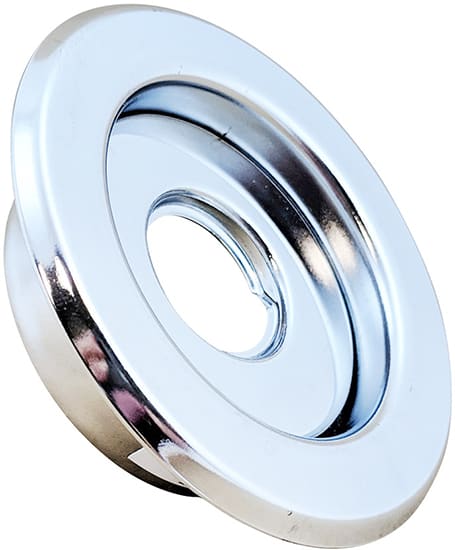
These sprinkler accessories offer aesthetic benefits: they provide a clean, finished look and hide the unsightly hole where a pipe fitting and sprinkler meet. But they also help keep a building’s occupants safe.
The vast majority of sprinkler heads activate when exposed to enough heat. A tiny component on each head (a bulb or metal solder) detaches at a specific temperature, allowing water to flow. If installers leave a gap around the mounting surface, heat may bypass the sprinkler, delaying activation.
Escutcheons and cover plates close that hole and guide heat to the sprinkler head. Similarly, concealed cover plates break open during a fire at a lower temperature than the one that activates the sprinkler, allowing heat to rise to the sprinkler head.
Concealed sprinkler heads are harder to install, but it’s easier to replace covers—the reverse is true for recessed sprinkler heads and replacing escutcheons
While both concealed and recessed fire sprinkler heads are roughly equal—with each providing aesthetic and life-saving benefits—not every aspect of them is identical from a buyer’s or an installer’s perspective. A few key factors impact the cost and ease of installation and replacement of parts:
- Concealed sprinkler heads are connected to rigid pipes and fittings and require exact placement when they’re installed. If the pipes sit too close or too far away from the wall, the cover plate won’t seat correctly (and the sprinkler’s spray may not reach its destination).
- Cover plates quickly push or thread on to a concealed sprinkler head. They’re easy to connect, but they’ll need to be replaced if a fire (or any excessive heat) causes them to detach. Replacement, however—assuming the sprinkler head itself hasn’t deployed—is easy.
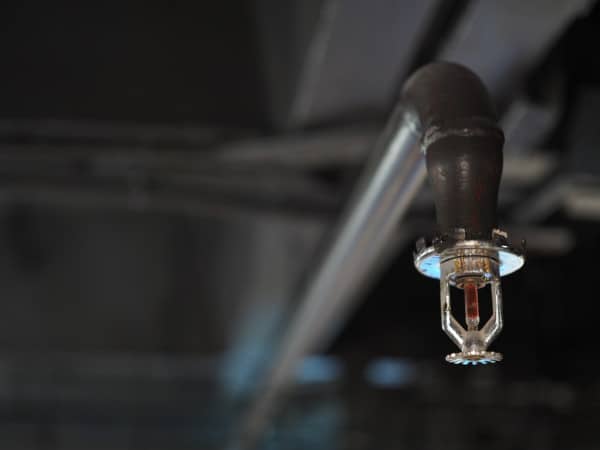
- The inner ring of a recessed escutcheon usually sits between the sprinkler head and the pipes above or behind it. As a result, putting in a replacement escutcheon can be difficult: it may be necessary to shut off the system, drain the pipes, remove the sprinkler head, and then attach the new escutcheon. Split-ring escutcheons (more on them later) might avoid this inconvenience.
- When it comes to installation, however, recessed escutcheons work fairly well with rigid pipes. An adjustable escutcheon allows the sprinkler to sit a little deeper in the wall or ceiling, if need be, giving installers more room for error.
SIN numbers define specific models, simplifying the purchase of concealed and recessed heads and their accessories
Leading sprinkler manufacturers offer a wide range of concealed and recessed sprinkler heads. But once a sprinkler’s been installed, the available options for cover plates and escutcheons diminish considerably.
If a cover plate breaks or activates, it must be replaced with a manufacturer-recommended alternative. The same is (mostly) true for recessed escutcheons. While there are some generic replacements—ones that, for the most part, haven’t been tested with specific sprinklers—many fire codes prohibit the use of escutcheons not specifically listed for a given sprinkler.
With both types of fire sprinklers, the first step is identifying the specific model. We’ve written an in-depth guide to sprinkler identification, but the simple version goes something like this:
- Remove the cover plate (if applicable) by gently twisting or tugging at it.
- Look at the sprinkler’s deflector—the forward-facing metallic tip at the end of the head.
- Take note of the sprinkler identification number (SIN). It’s a four-to-six-digit code with a mix of letters and numbers that identifies the head’s manufacturer and model.
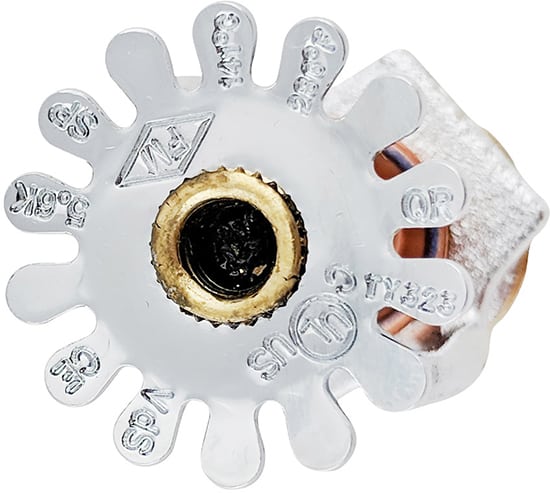
- If you’re replacing a cover plate, take note of the sprinkler’s temperature (also found on the deflector).
- Enter the SIN into your preferred search engine and look for the manufacturer’s data sheets—brief documents that identify and describe sprinklers. QRFS also offers guides to escutcheons—with a list of SIN numbers—for most Viking, Victaulic, Tyco, Gem, Star, and Central heads.
- Look through these documents for tables or lists containing compatible accessories. Most offer model numbers (or part numbers) along with a list of available finishes. Pay careful attention to cover plates’ activation temperatures. Even if a cover plate looks and fits like an exact match, a plate with a temperature that’s too high will delay the activation of a sprinkler—with potentially deadly consequences.

A few important factors guide the selection of accessories for recessed and concealed sprinkler heads
Escutcheons for recessed sprinkler heads offer meaningful differences for installers but few aesthetic options for end-users
Manufacturers often provide several compatible escutcheons for one type of recessed sprinkler. Here’s a look at the critical differences between them:
- Thread size. Most types of fire sprinklers have either 1/2″ or 3/4″ threads—and the inner ring of each escutcheon should fit tightly around them. Fortunately, almost all sprinklers with the same SIN have the same thread size. If you can identify your head, finding the matching size is easy.
- Inner and outer diameter. Both dimensions relate to the size of the hole in the surface. The inner diameter must be small enough to allow the escutcheon’s body to slide inside the wall or ceiling, while the outer ring must be large enough to cover the gap comfortably.
- Adjustment. Tyco, for example, sometimes offers two adjustable escutcheons for the same head: one that recesses 1/2″ and another that goes as far as 3/4″. The greater adjustment offers installers more room for error when working with rigid pipes.
- Because recessed sprinkler heads remain visible after installation, most escutcheons are made in finishes matching the color of the sprinklers themselves. White, brass, and chrome are among the most common, although others—such as black, off-white, or aluminum—are sometimes offered.
- Listed or generic. As we’ve mentioned, fire codes often require escutcheons to be tested and approved for use with specific sprinklers. There are, however, some generic escutcheons that fit a wide variety of fire sprinklers. It’s critical to reach out to local fire officials before installing them, but they can be especially helpful when dealing with obsolete or discontinued fire sprinklers.
- Split or non-split. Most manufacturers’ listed offerings consist only of non-split Replacing them requires shutting down part of the system, draining pipes, removing the head, and reinstalling both the sprinkler and the new escutcheon. However, some generic models are split-ring types that can be installed far more easily. These feature a two-piece assembly that clips around the sprinkler’s frame. Contact your authority having jurisdiction (AHJ) to determine if you can use them. QRFS carries 1/2″ white and 1/2″ chrome models.
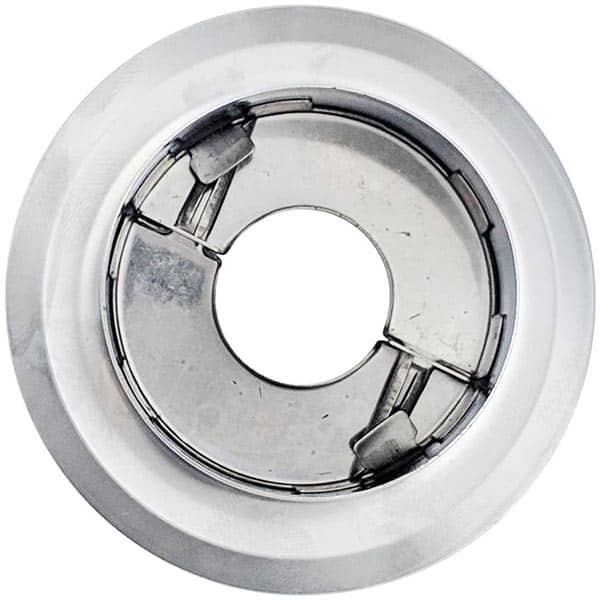
Most concealed sprinkler heads have one (or two) matching cover plates, but a wide variety of aesthetic options are usually available
There are some cosmetic differences between various cover plates. Some manufacturers may offer a disc-shaped and a square-shaped plate for the same head. Others may provide domed plates that, like smoke alarms or light fixtures, protrude from the ceiling slightly. And still others may offer them in different sizes to accommodate larger and smaller holes around the head.
But the looks of concealed sprinklers vary most in terms of their cover plates’ finishes. Most end-users want a plate that provides a handsome complement to a wall or ceiling’s surrounding paint (or, when possible, an exact match between the cover plate’s finish and surrounding surface). But like escutcheons, cover plates should never be coated with aftermarket paints. Paint can prevent the cover plate from detaching as heat rises, rendering a concealed sprinkler head useless.
Fortunately, major sprinkler manufacturers have done a great deal to make these products’ finishes palatable, with options including:
- Standard finishes. Like escutcheons, cover plates for recessed sprinkler heads are widely available in a white or off-white, along with chrome. Black, beige, and other solid colors are often offered as stock finishes—meaning that price doesn’t vary all that much between models.
- Specialty metallic finishes. Depending on the manufacturer, copper, nickel, brass, and other metallic finishes may be available as stock finishes.
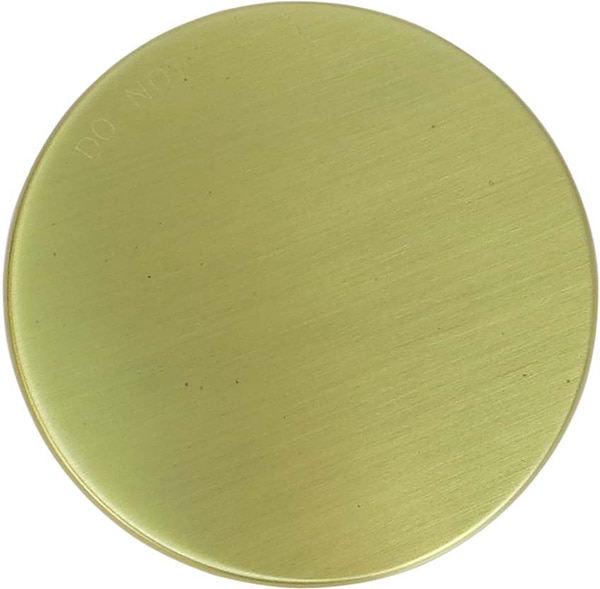
- Wood finishes. Senju Sprinkler offers one of the widest selections of cover plate finishes, including patterns that closely resemble natural wood grains. Plates that resemble oak, walnut, and Douglas fir can be effectively camouflaged in walls and ceilings made from natural materials.
- Custom colors and finishes. Contractors looking to place large orders can secure cover plates in almost any color or finish imaginable. Various brands will provide custom-painted plates based on specific paint manufacturer’s paint codes or with provided samples. You can even provide images to make plates resemble almost anything. Read this blog to learn more about ordering custom cover plates.
Stay safe and code-compliant by matching your concealed and recessed sprinkler heads with the right accessories
Escutcheons and cover plates—while simple and relatively cheap—are essential to a sprinkler’s normal operation. They’re not products where “almost fits” or “seems good enough” will cut it. Explore our selection of escutcheons and cover plates, or find a specific model by using the search bar at the top of the page. And if you’re struggling to find the right fit for your concealed or recessed sprinkler heads, reach out: call +1 (888) 361-6662 or email support@qrfs.com.
If you’d like to learn more, check out articles on topics like:
- Understanding fire sprinkler head types
- Explaining sidewall sprinkler heads
- Cover plates and cleanrooms
- How to match sprinkler heads and cover plates
- Getting the right temperature for your concealed sprinkler head’s cover plate
- A guide to Tyco escutcheons
- Choosing Victaulic escutcheons
- A guide to Viking escutcheons
This blog was originally posted at blog.qrfs.com. If this article helped you, check us out at Facebook.com/QuickResponseFireSupply or on Twitter @QuickResponseFS.


